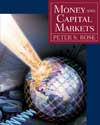 |  Money and Capital Markets: Financial Institutions and Instruments in a Global Marketplace, 8/e Peter Rose,
Texas A & M University
Interest Rate Forecasting and Hedging: Swaps, Financial Futures, and Options
Chapter SummaryThis chapter is devoted to the forecasting (predicting) and hedging (risk protection activities)
associated with changing interest rates and changes in the prices of securities and
other financial assets. It also examines basic patterns in the behavior of market interest
rates, exploring the linkages between interest rates, asset prices, and the economy.
- Interest rates appear to bear a close relationship to the economy, tending to rise in periods
of economic expansion and fall in economic recessions.
- Short-term interest rates tend to change more rapidly than long-term interest rates, moving
over a much wider range than long-term interest rates as economic conditions change.
- Several different methods of interest-rate forecasting have been employed in recent years,
though none have been consistently successful. Most forecasting approaches today rely
upon linkages in the economy and financial system, predictions of inflation, money-supply
changes, and changing expectations of borrowers and lenders in the financial
marketplace as reflected in such indicators as the yield curve and the prices and yields
attached to financial futures contracts.
- The great difficulties inherent in forecasting interest rates have led many borrowers and
lenders of funds to practice hedging, insulating themselves at least partially from the
ravages of fluctuating interest rates and asset prices in the financial marketplace.
- In recent years one of the most popular of all interest-rate and asset-price hedging tools has
been the interest-rate swap in which borrowing institutions exchange interest payments
with each other. The net effect of a well-drawn swap agreement is to achieve a better balance between interest revenue inflows and interest cost outflows. Frequently such
transactions also result in lower interest costs for both participants in a swap agreement.
- During the 1970s and 1980s financial futures and option contracts on a variety of debt
securities, stocks, and stock indices (such as the Standard & Poor’s 500-stock index) began
trading in the United States at the Chicago Board of Trade and the Chicago Mercantile
Exchange and, subsequently, spread around the world on multiple exchanges.
Both futures and options are contracts calling for the future delivery of securities or cash
at an agreed-upon price in an effort to set the price or yield on a future trade and,
thereby, lessen the risk associated with future price and interest-rate fluctuations.
- Hedging with financial futures contracts and options transfers risk from one investor to
another willing to bear that risk. The hedger contracts away all or a portion of the risk
of asset-price and interest-rate fluctuations in order to lock in a targeted rate of return.
This is accomplished by taking equal and opposite positions in the spot (cash) market
and in the forward (or futures) market or by purchasing put or call options to deliver or
take delivery of designated assets or futures contracts at a stipulated price on or before
a specific date.
- If interest rates are expected to fall and an investor desires to lock in a current high yield
on a security or other financial asset, he or she would buy a contract calling for the future
delivery of the security (or other financial asset) at a set price (i.e., take on a long
hedge) or purchase a call option contract. An opposite set of buy-sell transactions in the
futures market (i.e., a short hedge) or in the options market (i.e., a put option) would
generally be used if interest rates were expected to rise.
|
|




 2003 McGraw-Hill Higher Education
2003 McGraw-Hill Higher Education